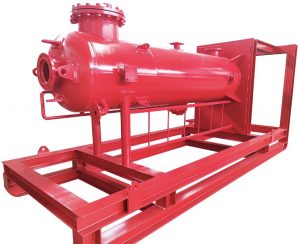Mud gas separators are the "kick-off" devices. We usually use the separators together with flare ignitors. Let's find more details below.
Mud gas separators specifications
There are main specifications including vessel size, thickness, design code, pipelines and fittings model, design pressure, material, and so on. Vessel size means the diameter and the height or length of the main vessel body. Flow rate and degassing capacity define the vessel size. For example, 800GPM or 1500GPM. The thickness is the gauge of the profile used to build the vessel. Such as 10mm, 12mm, and so on. Of course, the working pressure or design pressure determines the sheet thickness.
The design code affects material selection, too. Design code including ASME, GB standard, and so on. If we need to certify the separator under ASME and get the seal, there is a very definite requirement for materials. Pipelines and fittings including the inlet line, discharge line, vent line, drain port, valve and so on. Besides the pipe size, such as 5", 6", 8", 10" we also should pay attention to the length, pressure, as well as flange end specs.
For example, there is mud leg on the gas separator, it's also mud seal. That means the liquid level of discharge line after degassing. It helps to prevent separated gas flow back to the drilling fluids. Usually, the mud seal is no shorter than 3ft some clients request 5ft or longer according to the actual design of the degasser.
More information of the degassers
We know the degassers inlcuding vertical type and horizontal type. Usually, we use the vertical degasser. It occupies a less foot print. Furthermore, the horizontal degasser and vertical degasser are different with each other on some tinies. Such as vent line design, different ports arrangement, and so on.
The internal buffle blades helps to break the bubbles when drilling mud drop down from higher end of vessel. Then the gas will get released out of bubbles. Besides the internal buffle blades design, there is another pattern to let the gas out of bubbles. It's a hopper upside down, so when the fluid pass through the inlet port, the dimater of hopper suddenly becomes large and drop down swiftly, then the bubbles break and air flow away to the top and vent & ventilation.
Material grade is another issue users may concern. If the H2S content is high we'll consider the material resistant H2S and corrosion allowance. So, there is Q355, 16Mn, Q455 and so on material.
The external painting is an important factor of quality. We usually do the sand-blasting before the first layer epoxy zinc rich primer. The DFT is no less than 75 microns, then the epoxy MIO no less than 100 microns, and then Polyamide Cured high build epoxy 75 microns, finally the Aliphatic polyurethane 50 microns, finally the DFT is no less than 300 microns.
Tiny details of liquid gas separator
Here we'll talk about more details of separator components or little parts. Such as the flanges, the relief valves and the pressure gauge, lifting lugs, supporting legs, and so on.
Flanges are used to connect pipelines between degasser itself and the extension line. Such as inlet line port, will connect the line from choke manifold, and the discharge line connects to the shale shaker feeder, while the vent line connects to the flare ignitor gas line. We need to pay attention to the flange pressure, and the standard. Such as 1.6Mpa, or 4.0Mpa, is it an ANSI standard or a metric flange. Is it a steel one or a stainless steel one? About the pressure gauge, do we need the normal pressure one or a high pressure one?
Regards to the legs, do we need the laydown supporting leg or not? For the supporting frame, do we need the regulated one or a fixed one?
Furthermroe, you can order the extension vent line up to 100m along with the poor boy, or you can fit that yourself. Pay attention to the flanges, should be same model or size with ours.
Ye, there are so many different configurations. Please come to us and get the optimal solutions to the degassers. Leave comments below or call us freely.




